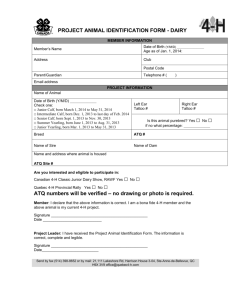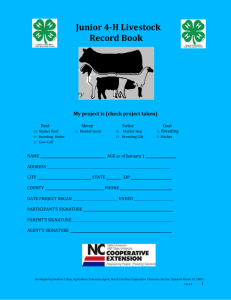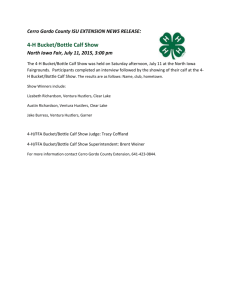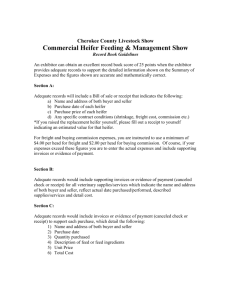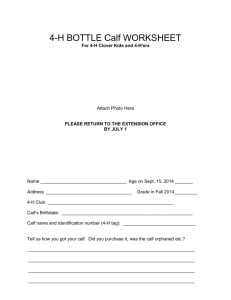Junior Breeding Beef Record Book - Washington County Extension
advertisement
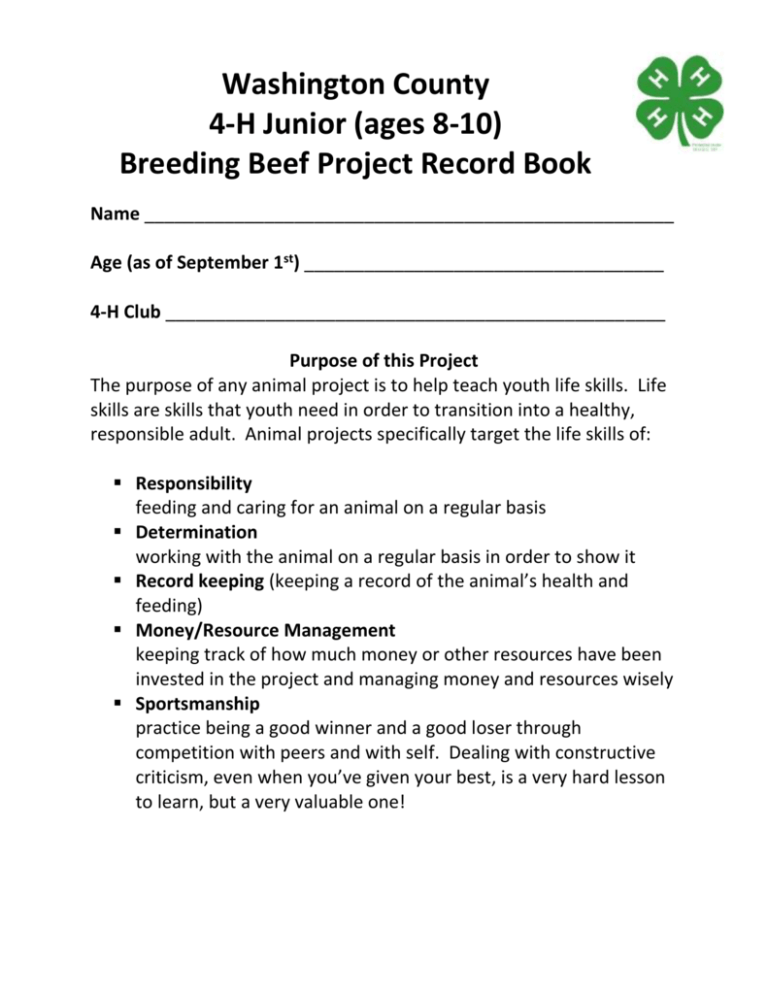
Washington County 4-H Junior (ages 8-10) Breeding Beef Project Record Book Name _____________________________________________________ Age (as of September 1st) ____________________________________ 4-H Club __________________________________________________ Purpose of this Project The purpose of any animal project is to help teach youth life skills. Life skills are skills that youth need in order to transition into a healthy, responsible adult. Animal projects specifically target the life skills of: Responsibility feeding and caring for an animal on a regular basis Determination working with the animal on a regular basis in order to show it Record keeping (keeping a record of the animal’s health and feeding) Money/Resource Management keeping track of how much money or other resources have been invested in the project and managing money and resources wisely Sportsmanship practice being a good winner and a good loser through competition with peers and with self. Dealing with constructive criticism, even when you’ve given your best, is a very hard lesson to learn, but a very valuable one! “As the exhibitor of this project, I certify that I have personally kept records and completed this record book.” Signed ____________________________________________________ Member Date “This youth is an active member of the ________________________ 4-H Club or FFA Chapter. This book has been completed by the youth and is an accurate record of the project.” Signed ____________________________________________________ Club leader or Chapter advisor Date Keeping records is an important part of any project, but especially for a market animal project. If you don’t keep any records, then you have no idea whether you made money or lost money at the end of your project. General Records What is the breed of your animal? When did you take possession of your animal? Do you plan on breeding your animal? If so, are you going to breed it naturally (by putting a bull in the pen or field) or by artificial insemination? What date(s) do you plan on breeding your animal? What do you plan on doing with any animals that are born? (sell, raise, etc) 2 Breeding Beef Timeline Birth of calf Record weight, date of birth and tag calf if possible 1-4 months Begin to introduce feed – Calf may eat along with mother. Have as much contact with calf as mother will allow!! 4 month First set of vaccines: Contact local vet for more info 4 month Castrate bull calves early (preferable in cool weather when flies are not a problem) Worm calf (pour on if show calf prospect) 5-6 months Continued to feed and work with calf 6-7 months Wean calf continued to feed and work with calf Booster Vaccines, worm again 8-15 months Feed – Feed – Feed 15 months 750 lb. minimum before breeding. Select a calf ease sire for your heifer and bred 15-24 months Feed – Feed – Feed 24 months Watch for calving 24 months+ Vaccinate and Worm (Spring and Fall) * Remember it takes 9 months for a cow to calve. Plan your calving time around the fall of the year if possible. 3 Expenses and Income An expense is something that you pay for, or that costs you money. Your project expenses include the cost or value of your animal at the beginning of the project, what you paid for feed, what you paid for veterinary bills, and what you paid to show your animal. Income is money that your project brings you. Examples of project income include what your animal is worth at the end of your project (or what someone pays for your steer), and any show premiums you win. Your project begins the day that you take possession or responsibility of your animal. PROJECT EXPENSES Animal Expenses What you paid for your heifer (or the value of your heifer if it is given to you or you raised it your self). If you bought your animal, simply write down the actual purchase price. If you were given your animal, or if it was born on your property, or if it was leased, simply write down the fair market value. As a general rule, a yearling breeding animal is worth $750.00. Value of Animal at Start of Project: $___________________________________________ 4 Feed Expenses Date Type (Hay, Supplement, Grain, etc) Pounds Cost TOTAL FEED EXPENSES Veterinary Expenses Date Treatment TOTAL VETERINARY EXPENSES Cost $ 5 Show Expenses Date Type TOTAL SHOW EXPENSES Cost $ 6 PROJECT INCOME Show Premium Income Date Name of Fair or Show TOTAL PREMIUMS WON Class Placing Premiums Won $ Animal Income As a general rule, a mature cow (2 years or older) is worth a minimum of $1,200.00. A yearling calf is worth a minimum of $750.00. You can use these general guidelines to calculate the total value of your breeding animal(s) at the end of your project. What is the value of your animal(s) at the end of your project? $_______________________ 7 FINANCIAL SUMMARY Project Income Animal Income $_________________ Sponsorship Income $_________________ Total Project Income $_____________ Project Expenses Animal Expenses $_________________ Feed Expenses $_________________ Veterinary Expenses $_________________ Show Expenses $_________________ Total Project Expenses $_____________ TOTAL PROFIT OR LOSS $_____________ Subtract your total project expenses from total project income. This is your total profit or loss. 8 Club & Leadership Development Activities Record your activities from March 1, 2013-February 28, 2014 4-H Awards or Honors 4-H Project Learning Activitie 4-H Project Presentations/Demonstrations/ Competitions/Exhibits 4-H Community Service Activities 4-H Fun Events/Activities 4-H Leadership Activities Other Organizations, Awards, Hobbies, Interests 9 Project Photos Include at least three photos of your project with captions that describe what is happening in the pictures. If you like, you can add pages to include other items and memorabilia, such as your exhibitor numbers, stall cards, ribbons won, etc. 10 Washington County Youth Fair – Large Animal Science Project Youth Survey Choose the best answer for you. As a result of participating in a large animal science 4-H or FFA project: Check one answer for each question. Almost never Sometimes Usually Almost always I don’t know 1. I take care of my animal daily. (provide food, shelter, water, groom) 2. I train my animal on a regular schedule. 3. I can demonstrate safe behavior around animals. 4. I record the expenses and income for my project. 5. I can list the costs and work involved with my project. 6. I can identify the body parts of my animal. 7. I can explain the breed characteristics of my animal. 8. I can demonstrate how to groom my animal. 9. I can answer questions about my animal. 10.I am thinking about a future career in agriculture or a science field. Look at the list of Life Skills below. Put a checkmark by the TOP 3 skills you’ve learned as a result of participating in your large animal science project. (Put your check in the column to the left of the word) Leadership Teamwork Self-Motivation Self-Esteem Responsibility Self-Discipline Social Skills Personal Safety Learning to Learn Decision Making Problem Solving Critical Thinking Service Learning Goal Setting Planning/Organizing Keeping Records Communication Cooperation Using complete sentences, answer the following: One thing I will definitely do next time One thing I will change for next time The most important skill I learned I need more information on Information about you: Age Years in 4-H Years in this project _____Male Years in FFA _____Female Will you show next year? _____Yes ____No 11 This document was developed by Heather C. Kent, and Doug Mayo, August 2006 and revised by Julie Pigott Dillard, December 2009 & 2014. The Institute of Food and Agricultural Sciences is an equal opportunity/affirmative action employer authorized to provide research educational information and other services only to individuals and institutions that function without regard to race, color, sex, age, handicap, or national origin. For information on obtaining other extension publication, contact your County Extension Service Office, Florida Cooperative Extension Service/Institute of Food and Agricultural Sciences/University of Florida. 12 13
